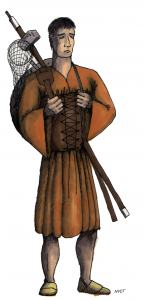 Player – Yeah, we’ve got food.
Player – Yeah, we’ve got food.
GM – You have enough for the whole trip?
Player – Um, yeah, sure we do.
No one wants to deal with tracking consumables. It’s not fun. Most consumables just get ignored anyway. The player says “I’ve got a hundred, if I don’t bother to erase one or two, it won’t matter.” The GM says “Okay mark it off your equipment.” and hopes the players are keeping an exact accounting. It’s good enough in most games because the players are usually good about being accurate with Hit Points and money but if you try to add any more accounting and everyone starts to gloss over it as unimportant.
But what about when those consumables, like food, is important to the story of a survival game? Even if you tell players it’s important, they don’t want to have to deal with it. Maybe it’s the modern day concept of food that makes tracking food hard. After all if you’re hungry, just pop over to the kitchen and eat something.
The GM can try to keep track of it but it’s not a lot of fun and for some reason the players feel that the GM is just trying to doom them by forcing them to run out of food. The players don’t buy into the idea of food scarcity.
Breaking it down
One of the problems in tracking food is that we don’t eat in units. We eat in meals but how much is a meal? How much volume, how much mass? Backpackers have to think about this question a lot and usually think about how much food they need for the day in terms of mass (or weight). Backpackers fine tune their food for the most calories for it’s weight and it would make sense that an adventurer would do something similar. Ultralight backpackers talk about carrying 0.7 Kg (1.5 Lb) of food per day but most backpackers say that’s too little to subsist on comfortably. It does give us a good baseline though of what a minimum for an active person’s needs.
So then, if we just go by mass, if a character carried 25 Kg of food, they could carry 35 days worth of food. Unfortunately, that’s pretty unrealistic. The reason is that although the food is light, it’s bulky. In my experience when I would go backpacking we could carry four days of food comfortably and we figured that if we wanted to, we could conceivably pack for eight days but that would be almost all we were carrying besides our tent and sleeping bag.
This is our second benchmark then, lets say 4 days of optimally chosen food takes up one third of a large backpack but only has a mass of 2.8-4 Kg.
So what does that do for us? A large backpack represents almost the limit of what a human can practically carry as far as bulk. The GM can now say “How much of your pack(s) are you devoting to food? Four days takes up a third of the pack.” Negotiating a pack’s contents should be a little more manageable for the players. Now everyone knows they can travel for four, eight or twelve days. Just don’t forget to bring water. . .
Next up, Rationing Mechanics.


 The Free RPG Blog
The Free RPG Blog
Speaking of “don’t forget to bring water”, I would expect that that 1.5 pounds of food per day is packaged using modern techniques (freeze drying, dehydration, etc.). There would probably be a certain amount of that going on in most RPGs but I would probably do a bit of research before using what we have available now to decide on what would be available (based on preparation and preservation techniques and equipment) in a survival RPG (or pseudo-medieval fantasy RPG).
The 1.5 pounds is the actual weight of the food. While freeze drying is a modern technique, dehydration is very old and would be a suitable option. Really most trail choices could be done in a ancient setting with only a few modifications but culturally might be anachronistic. Still hard tack, raisin or date cakes and dried jerky would fall right into the same weight range and probably still take up a similar volume.
Hardtack and beef jerky (and pemmican) came to mind while I was writing my previous comment, so it makes sense to me that you could have such things available..
The only other question I’d have about it is the likelihood of having such preserved food available when you need it. Today you can just go to an appropriate store and buy it, and might even keep a ‘trouble bag’ handy you can grab and run.
In other settings or situations you might have to make do with unpreserved food (hunting and foraging as you travel, or “grab what you can and run” “preparation” for a journey).
In other words, while it’s good for planning and design purposes, it might be worth remembering there are situations you could end up carrying two or three times the weight and volume because the dried goods aren’t available when you need them to be.
That’s true about availability but dried food is pretty standard for ancient communities. If you didn’t dry it, salt it, pickle it, or ferment it then you only had it at harvest. Even canning is a relatively new invention. So unless you’re hitting a community at harvest time, there’s likely to be various dried foods and meat. Hard tack could be made by any baker in a matter of hours.
As for foraging I did a post on that here but I want to do a little more to flesh the ideas out.
Hmm. Good point — drying is likely to be a significant preservation mechanism (salting doesn’t dehydrate quite as much). Okay, it’s probably fairly easy to find dried foods. Maybe not always at hand (hams aren’t dried, but they are salted, and most vegetables are unlikely to be dried — root vegetables do okay as long as you keep them cool and dry — but you can probably find dried meat and certain fruits.
Pingback: Survival Games – Food Theory | The Artifact RPG